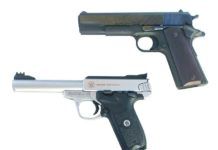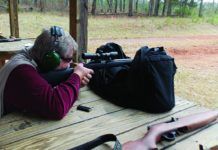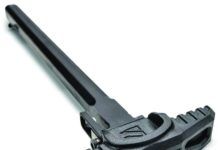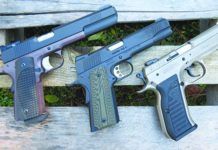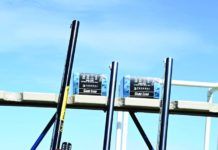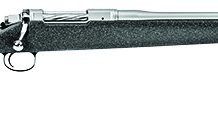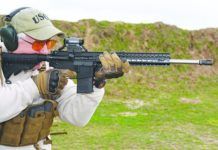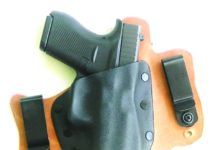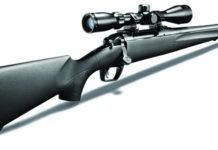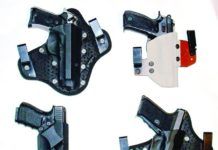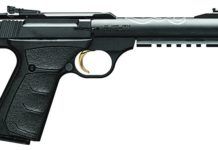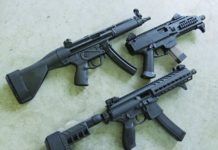22-Caliber Handgun Shoot-Out: Smith, TacSol, Beretta, Colt
In this installment, we are looking at some of the best 22-caliber pistols for all-around target shooting and training for marksmanship and personal-defense practice, with an emphasis on viability for personal-defense training. Some handguns are just fine for general plinking, but the modern shooter demands the ability to train with combat lights or even a red-dot sight. All 22s do not allow this type of versatility. Let's look at four 22-caliber handguns and see how they stack up as modern trainers.
The 22 self-loading handgun is a great firearm that every handgunner should own at least one of. The 22 is a great trainer, and it is also a good small-game handgun, and it is even useful in some forms of competition. The absence of recoil and muzzle report compared to centerfire handguns is often touted, but recoil and muzzle blast are there, simply in easily manageable portions. The shooter is free to concentrate on trigger press, sight picture, sight alignment, and grip. Practice in offhand fire, combat practice, firing for extreme accuracy from a solid rest, clearing malfunctions and hunting game are just some of the practice that may be accomplished with the 22 pistol. For small-game hunting, excellent accuracy is demanded. For combat practice—and this is an important point—the handgun should be similar to the centerfire defense gun in accuracy. In that manner, the shooter isn't given a false sense of security by a 22 that is much more accurate than the 9mm or 45 they use for personal defense. When practicing with the 22, the serious shooter should use the same grip and trigger press that he or she uses when mastering the 9mm or 45. Using a lighter grip or shooting fast just because the 22 is so controllable doesn't cross over into personal defense skills; it is simply shooting for fun.
We collected two 22-caliber handguns and two 22-caliber conversion units for comparison. One of the handguns is a new model and the other, a relatively new and often overlooked pistol. The firearms tested included the Smith & Wesson Victory 22, Beretta Neos 22, Tactical Solutions' Glock conversion unit, and a Colt 22 Ace conversion unit.
Rimfire Field-Rifle Shoot-out: Marlin, Mossberg, and Ruger
In this installment, we test three rimfire rifles from three makers. The genre is the very popular and flexible field-gun description. The 22 LR rifle is an excellent trainer, a favorite recreational shooter, and a great small-game rifle. The rimfire is the one rifle every rifleman must have. The field gun is by definition, and the definition is liberal, a versatile go-anywhere get-anything shooter. Informal practice and small-game shooting are great pastimes. And while we are not focusing on personal defense, we should note that a good quality 22-caliber self-loader is a formidable firearm in skilled hands. Is a 22 LR a self-defense chambering we'd recommend? No. Have untold numbers of bad guys been deterred by being hit with a 22 LR round fired from a pistol or rifle? Yes. So reliability is important as well.
The rifle we are looking for should be light but not too light. It should be light enough for carrying for a day in the field, but it should have sufficient heft for good offhand shooting. While we carefully measure accuracy by firing from a solid bench rest, we also want a rifle that retains a good portion of its accuracy in offhand fire. Thus, a good balance of weight and a decent trigger action are desirable traits.
Historically, probably more 22 LR rifles have been set up as bolt actions, but because of their light recoil and shot-to-shot speed, self-loading rifles are the biggest sellers today. To keep prices in check, we selected a mix of readily available used and new firearms as well as optics for greater coverage of the best choices. As noted above, reliability is always important, but in this test, we allowed that if the firearm occasionally ties up and we lose a squirrel, we were more willing to give a gun a pass than if we were testing personal-defense firearms. It is almost a given that a 22 self-loading rifle malfunctions from time to time, and the fault is more often due to the construction of the 22 rimfire cartridge than any other single variable. We searched for ideal rifles and found some good picks. All had good points. Here's how they performed on a gun-by-gun basis.
New Accessories, Gear, and Ammunition Choices for 2017
As prices continue to come down as the result of a gun glut (supply and demand economics), more folks will be buying guns, and we'll want to shoot them. So we will be adding enhancements to those firearms and feeding ammunition into them with a big grin. Here are some new products Gun Tests' staffers have taken note of that will make your firearms run, run better, or add fun.
Three More 10mm Autos: Kimber, Dan Wesson, Tanfoglio
Last year we tested three 10mm Auto pistols and found there was a lot of interest in these big-bore handguns, so we decided to return to these powerful handguns for another look. Our most recent crop of 10mms includes two 1911 platforms and one based on the CZ 75 platform. The Kimber Custom TLE II and the Dan Wesson Bruin Bronze share the 1911 platform, while the Tanfoglio Witness is based on the CZ 75 design. We liked all three of these pistols and found that all three could serve multiple duties from hunting to self-defense. Since the 10mm has the power of a 41 Magnum, we feel it is a bit much for everyday carry. If we ever were in a shooting incident, it's possible the overpenetration of the 10mm could be a liability. But in a self-defense situation where you are facing an angry bear in the back country, we think the 10mm Auto makes perfect sense. Also, as a hunting round, the 10mm offers a lot of power and is well suited for game like deer and pigs at short distances. We'd even use it in a tree stand to take black bears visiting a bait.
All three pistols ran exceptionally well with no malfunctions or jams, and we found they were accurate. Two-inch five-shot groups at 25 yards were the norm. For ammunition, we used SIG Sauer V-Crown Ammunition loaded with an 180-grain JHP bullet. The SIG ammo was loaded to velocities that 10mm Auto was designed for.
The other two loads were Federal American Eagle and Armscor USA labels, both using 180-grain FMJs. These two rounds weren't as hot as the SIG load, as the table data reveal. The SIG ammo factory data shows a muzzle velocity of 1250 fps; we got very close to that muzzle velocity from the Kimber and Dan Wesson. The Tanfoglio produced less velocity. The Federal and Armscor ammo is factory-speed stamped at 1030 fps and 1008 fps, respectively. With the three pistols, we saw higher muzzle velocities than the factory figures.
For accuracy testing, we used a rest and open sights, firing at targets placed 25 yards downrange. For our speed stage, we fired at 10 yards. A fast and accurate follow-up shot was faster with the Bruin and Witness, which we will get into shortly. Remember that a 10mm Auto is not a learner's pistol or for those who are sensitive to recoil. In our opinion, the Bruins and the Witness helped us manage recoil the best. Shooting this trio side by side at the range, we learned a lot about them. Here's the skinny on all three.
Brownings Sweet Sixteen: Still Sweet After All These Years?
The popularity of the 16-gauge shotgun, in particular the Browning A5 Sweet Sixteen, has never waned among those select shooters with a streak of nostalgia in their genetic makeup. A common refrain of, "I've still got my granddad's old 16 — best bird gun ever made," is often heard whenever veteran shooters gather to share tales of old or create new memories of quality time in the outdoors.
Responding to a reader's request, we decided to give the recently unveiled Browning A5 Sweet Sixteen that premiered at the 2016 SHOT Show a closer look to see what motivates the 16 gauge's small, but very loyal, fan base. The new semiautomatic is built with a smaller, lighter receiver than the old-style Humpback and utilizes a different recoil system than the long-recoil creation of legendary firearms genius John M. Browning, so only time will tell if it has the lasting power of its predecessors.
The Light Twelve was added to the mix for a couple of reasons. First, the older Sweet Sixteen is built on the same-sized frame as the 12 gauge. Also, we wanted to see if the 16 gauge lives up to its reputation as a more sporting shooting tool. And, of course, 12-gauge ammunition is much more available than 16-gauge shotshells, and if the potential wingshooter is in the market for one of these Humpbacks, how much will nostalgia and pride of ownership of a "Sweet Sixteen" override the economics of shooting the bigger gauge, assuming similar performance?
New Rifles at SHOT 2017
At the 2017 Shooting, Hunting, Outdoor Trade (SHOT) Show in Las Vegas in January, Gun Tests staffers saw that although new modern sporting rifles do not dominate the introductions of rifles this year, another major manufacturer has entered that AR-15 market with a product that's selling well. So now's the time to buy your AR because prices should be falling.
Of course, you should find plenty new to like elsewhere in the 2017 rifle world, with new rimfire offerings, new youth offerings, and plenty of threaded muzzles for those suppressors that may be deregulated soon.
AR-15 Carbines for Less Than $1300: The Winner is a Saint
A staff member recently paid $2300 for a complete AR-15 carbine without regret. But you may have noticed complete uppers selling for as little as $400 during the last rounds of holiday sales and complete carbines selling for less than $700. Why pay more? One answer would be to take advantage of the latest technology in terms of manufacturing, helpful features and improved ammunition. Forged rather than cast aluminum is now the standard, and machining is more exact thanks to computer numerically controlled (CNC) automation. The efficiency and versatility of barrels have been upgraded to take advantage of heavier bullets able to land a more effective blow at greater distance. Barrels with twist rates of 1:8 inches and even 1:7 inches have replaced the original-issue lands and grooves that spun the bullets at a rate of 1:9. Handguards are now modular platforms for lights, lasers, and sights, and ambidextrous fire controls are becoming more popular as well.
With the desire for a more up-to-date AR-15, we went shopping and found that we didn't have to break the bank — just get comfortable within a price range of about $900 to $1250 dollars. What we came up with was three AR-15s with upgrades that distinguished them from more traditional models.
Holsters for the Glock 42: We Test Ten for Everyday Carriers
The Glock 42 380 ACP is becoming a very successful handgun since its introduction three years ago, which has lead to many makers large and small rolling out holster rigs for this handgun. The Glock 42 is exceptionally well balanced but light, so it may require a little extra effort to be certain the Glock 42 is sheathed with a balance of speed and retention. Short and light guns sometimes roll out and require extra effort to holster securely. Fortunately, a number of makers offer good designs for this handgun, as we recently found out.
The Glock 42 is every bit a concealed carry handgun, and we think it is too important to go cheap on a holster for this activity, and you probably need more than one holster to cover all the different ways you or your spouse might carry it. Some of the holsters we tested below represent a good deal for the price and seem to do as well as others with more features. Here's what we thought about ten holsters that may suit your Glock 42 needs.
308 Winchester Bolt-Actions: Remingtons M783 Rifle Wins
Among the most useful, versatile, and powerful all-round sporting rifles is the 308 Winchester bolt action. These rifles are accurate, reliable, and can take on small to big game in many hunting conditions. When married with a good optic and in competent hands, they are well suited to take a 200-pound target at 200 yards and beyond, as a rule of thumb. The chambering is a joy to use and fire, compared to hard-kicking magnums, and offers plenty of recreational value. The bolt-action 308 is also a useful tactical rifle in many situations, and the round is widely used by law enforcement across the country.
We recently took a hard look at four bolt-action rifles chambered in 308 Winchester, with a special emphasis on looking for affordable options. So we chose two used rifles and one lower-cost new rifle and compared them to a rifle in a higher price range to ensure we weren't missing something that more dollars could provide. These rifles included the now-discontinued Mossberg ATR, the Remington 783, the Remington 700 SPS, and the Savage Axis. In this quartet, we shot three loads for accuracy testing and another load in offhand fire to gauge the accuracy of the rifles. As it turns out, the economy combination rifle that comes from the factory with a bore-sighted scope is a good deal. Though the Remington 783 was the most accurate rifle, we also liked the Remington 700 SPS a lot. Overall, however, the Savage Axis combination seems a best buy. Let's look hard at these rifles and delve into why we made these choices and to see if you agree with our assessments.
Comfortable Holsters: We Test Four to See How Well They Work
The inside-the-waistband holster is the most concealable of all holster types, but it is also the least comfortable. The IWB holster rides close to the body, so when the temperature soars, perspiration is thick, and our clothes cling to the body, a leather holster may become soaked with sweat and adhere to the body. Also, a stiff Kydex holster may become uncomfortable in the same conditions. Perhaps, then, a mix of modern material may be the best bet for making an effective defensive handgun wearable and bearable. To find out if they offer a better ride for our handguns, we took a look at four holsters from StealthGear and Comfort Holsters. We found much to like. We also discovered that such comfort is expensive compared to conventional holsters.
We will cover a lot of ground in this review. But since the holsters make the claim for greater comfort, that must be the focus point of this test. Still, we first evaluated each based on its merits as a holster, and our team found these four to be viable concepts in terms of retention and presentation.
So, compared to other holsters of the type, such as hybrids and Kydex, will these holsters exhibit a higher degree of comfort? Are there trade-offs? In this case, any trade-off is minimal. There is no trade-off, we felt, with the Onyx design. The padding does not make the holster more difficult to conceal. The Onyx is about 10 inches across its breadth compared to 7 inches with the Bentley. However, when both are laid on a table, the Bentley is taller. So, if you have a weak lumbar area and need to spread the weight of the handgun out on the back for increased comfort—exactly the scenario one of our raters faced—the Onyx gets the nod. If your belt space is limited and allocation of belt space is important, the Bentley would seem to make more sense. Both perform well, and the Bentley seems to offer more ease when reholstering. For pure comfort, the Onyx seems to be the better bet, particularly if you share the back problems one of our raters had. Since the Onyx costs $25 less than the Bentley, that is also a plus.
New Handguns at SHOT 2017
The New Black Label 1911-22LR Gray full-size and compact models are available with or without a rail. The slides on both are machined aluminum, and the barrel has a gray anodized finish. The frames are composite, with a machined 7075 aluminum subframe and slide rails. Sights are fiber-optic. SRP: $699.99; $719.99 with the rail. A Black Label 1911-22LR Medallion full size and compact will also be offered with similar features for $670.
The Black Label 1911-380 Medallion Pro model, in full-size and compact versions, features a matte-black frame and a blackened stainless-steel slide with silver brush-polished flats. The grips are made of intricately checkered rosewood with a gold Buckmark. Barrel length on the full-size model is 4 inches; on the compact model, it's 3 5⁄8 inches. SRP: $800; $880 with night sights. Black Label 1911-22LR Medallion full-size and compact versions will also be offered with similar features for $670.
Forward-Mounted-Mag 9mm Pistols from SIG, Zenith, & CZ
In the October 2016 issue, we tested three high-capacity 9mm Luger pistols and found them somewhat lacking in defensive scenarios, though we did enjoy shooting one, the MPA Defender, which was sized more like a regular pistol than the carbine-like SIG MPX and which functioned better than an Uzi Mini Pro. But there are an increasing number of pistols that, save for a couple of features, function more like Short-Barreled Rifles (SBRs), which are controlled by much more stringent regulations under the National Firearms Act and are vastly more expensive and hard to get. The SIG MPX-PSB, for example, is similar to the unit we tested last October except it comes with a Stabilizing Brace, thus the "SB" in the name, compared to the "P" designation we initially tested.
This round, we found products more alike in size to the SIG Sauer MPX-PSB, namely, the CZ Scorpion EVO 3 S1 and the Zenith Firearms MKE Z-5RS with SB Brace. The Zenith and SIG came with a stabilizing brace, while the CZ did not, but it could be purchased separately. The SIG, CZ, and Zenith are tactical looking firearms because they all have a military ancestry that is especially noticeable due to the magazine mounted in front of the trigger guard and not in the grip. The three pistols tested are all semi-automatic, require two hands to shoot with any degree of accuracy, use high-round-capacity magazines compared to typical full-size handguns, and have the ability to be fired with a stabilizing brace. These pistols also represent three different operating mechanisms: the SIG uses a short push-rod gas system; the CZ a simple blowback system, and the Zenith a delayed roller-block mechanism. During firing, we noticed big differences in the mechanisms in both manual operation and cycling when fired, which we will get into. The ergonomics and controls differed as well, yet we found our ramp-up time transitioning between handguns to be short.
Initially, there is an awkwardness shooting these pistols because they feel like an SBR yet have no stock for a steady aim, and they are too heavy to fire in a Weaver, Isosceles, or hybrid stance with a two-hand hold like a typical handgun. We believe adequate range time and proper training is needed to master these pistols.
Most important, we wondered if, out of the box, these similar, yet different, pistols would work as home-defense choices. In our opinion, the upside of these three pistols is that they offer high magazine capacities, decent accuracy, and a lot of shooting fun. Yes, these pistols can make empty brass very quickly. On the downside is cost. Yes, you can purchase a lot less gun for a lot less money and achieve the same self-defense goal as what this trio delivers, we believe. Still, we looked forward to seeing what each firearm could do at the range.































